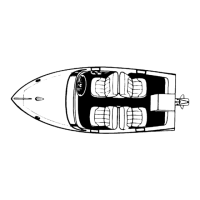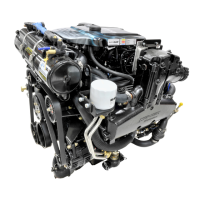ELECTRONIC FUEL INJECTION (MULTI-PORT AND THROTTLE BODY) - 5E-990-823225--1 1096
Service Precautions
The following requirements must be observed:
1. Before removing any ECM system component,
disconnect the negative battery cable.
2. Never start the engine without the battery being
solidly connected.
3. Never separate the battery from the on-board
electrical system while the engine is running.
4. Never separate the battery feed wire from the
charging system while the engine is running.
5. When charging the battery, disconnect it from the
boat’s electrical system.
6. Ensure that all cable harnesses are connected
solidly and that battery connections are thor-
oughly clean.
7. Never connect or disconnect the wiring harness
at the ECM when the ignition is switched ON.
8. Before attempting any electric arc welding, dis-
connect the battery leads and the ECM connec-
tor(s).
9. When steam cleaning engines, do not direct the
steam cleaning nozzle at ECM system compo-
nents. If this happens, corrosion of the terminals
or damage of components can take place.
10. Use only the test equipment specified in the diag-
nostic charts, since other test equipment may ei-
ther give incorrect results or damage good com-
ponents.
11. All voltage measurements using a voltmeter re-
quire a digital voltmeter with a rating of 10 meg-
ohms input impedance.
12. When a test light is specified, a “low-power” test
light must be used. DO NOT use a high-wattage
test light. While a particular brand of test light is
not suggested, a simple test, as shown below, on
any test light will ensure it to be safe for system
circuit testing. Connect an accurate ammeter
(such as the high impedance digital multimeter)
in series with the test light being tested, and pow-
er the test light ammeter circuit with the vehicle
battery.
b
a
a - Test Light
b - Battery
IMPORTANT: If the ammeter indicates LESS than
3/10 amp. current flow (.3 A or 300 mA), the test light
is SAFE to use.
If the ammeter indicates MORE
than 3/10 amp. cur-
rent flow (.3 A or 300 mA), the test light is NOT SAFE
to use.
NOTE: Using a test light with 100 mA or less rating
may show a faint glow when test actually states no
light.
13. When using a DVOM to perform voltage mea-
surements, turn the ignition OFF when connect-
ing the DVOM to the circuitry to be tested.

